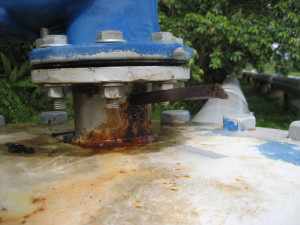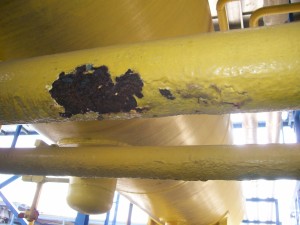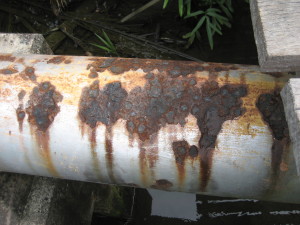
Important Aspects of Surface Coating for Anti-Corrosion

Introduction
Corrosion issues are clearly of economic costs and corrosion can lead to structural failures that have dramatic consequences for humans and the surrounding environment. Reports on the corrosion failures of metal structure, bridges, aircrafts, automobiles, buildings, and gas pipelines are not unusual. Both organic and inorganic coatings have been widely applied for the protection of metals against corrosion. In many areas of coatings technology the fight against corrosion has made significant progress in recent years. Despite significant improvements in corrosion coating technologies problems will continue to persist in the long term protection of metal from aggressive environments. Although the oil and pipeline industry has developed reliable cathodic protection methods and monitoring systems that permit safe operation in difficult environment, these industries also experience coating failures. One of the main reasons for the limited number of high performance anti-corrosive coating systems is the complexity of the coating substrate system and the large factors affecting the performance and service life of anti-corrosive coatings. Besides the composition of the coating, this consists of binders, pigments, solvents, extenders, and additives. The performance and durability of anti-corrosive coating depends on several different parameters, such as type of substance as well as several external environmental parameters. To perform its duty effectively, an anti-corrosive coating must possess intrinsic durability, adhesion to the substrate, adequate flexibility and toughness to withstand impacts and cracking as well as maintain its appearance when subjected to stress, swell, mechanical abuse, or weathering. The coating industry is a mature industry that has been undergoing a continual change in technology throughout the last few decades. An introduction to the different types of anti-corrosive coatings presently available, the main components in anti-corrosive coatings, novel anti-corrosive coating ideas and a summary of most important degradation mechanisms.
Although the oil and pipeline industry has developed reliable cathodic protection methods and monitoring systems that permit safe operation in difficult environment, these industries also experience coating failures. One of the main reasons for the limited number of high performance anti-corrosive coating systems is the complexity of the coating substrate system and the large factors affecting the performance and service life of anti-corrosive coatings. Besides the composition of the coating, this consists of binders, pigments, solvents, extenders, and additives. The performance and durability of anti-corrosive coating depends on several different parameters, such as type of substance as well as several external environmental parameters. To perform its duty effectively, an anti-corrosive coating must possess intrinsic durability, adhesion to the substrate, adequate flexibility and toughness to withstand impacts and cracking as well as maintain its appearance when subjected to stress, swell, mechanical abuse, or weathering. The coating industry is a mature industry that has been undergoing a continual change in technology throughout the last few decades. An introduction to the different types of anti-corrosive coatings presently available, the main components in anti-corrosive coatings, novel anti-corrosive coating ideas and a summary of most important degradation mechanisms. 1. Coating additives
Paint additives and coating additives include a wide range of materials added to polymer resins, paints and coatings and other substances to modify specific properties. They include insulating paint additives, powder coating additives, catalysts, wetting agents, levellers, clarifier, coupling agents, deflocculates, thinners, thickeners, anti-caking agents and other chemicals. Paint Additives and Coating Additives are available in many different forms. A wide range of paint additives, coating additives, insulating paint additives and powder coating additives made from the finest quality raw materials. These products are effective in providing water resistance, corrosion resistance, heat resistance and abrasion resistance. Our paints and coatings additives are safe and environment friendly.
 2. Anti-corrosion coating Features
2. Anti-corrosion coating Features- Two components mixing system
- Quick Drying at room temperature
- Self-Priming (No need to apply primer)
- Tough & Scratch proof
- Fire Resistance – BS-163
- Excellent resistance to U.V. Radiation
- Resistance to Acids, Alkalies & saline atmosphere.
- Stable up to 200°C
- Easy to apply by Brush
- No skill manpower requirement.
- Quick & Convenient
- Considerable reduction in painting time.
- Applicable on Ferrous & Non-ferrous metals.
- Saves cost as compared to conventional protective paints
- Reduces the delivery period due to fast & short painting process.
- Saves Manpower & Time.
- Equipment Structural Steel
- Industrial Valves, Motors & Pumps
- Control Panels, Transformers
- Pipe Lines, Storage Tanks
- MS Structures, Chemical Plants/
- Refineries/Thermal Power Complexes
 Specifications of anti-corrosion coating Function Polymeric based protective coating to protect Metallic Structures from Corrosion in varied climatic conditions. FeaturesSelf-Priming Two Component Air Drying Easy to Apply by Brush Physical properties
Specifications of anti-corrosion coating Function Polymeric based protective coating to protect Metallic Structures from Corrosion in varied climatic conditions. FeaturesSelf-Priming Two Component Air Drying Easy to Apply by Brush Physical properties- Form: Liquid
- Odour : Non
- pH : Neutral
- Density : 1.01 (+/- 0.02) at 27°C
- Viscosity : 24 sec. ( B-4 Cup ) at 270°C
- Touch Dry 60 minutes at 30°C
- Re-coating 90 minutes
- Hard Dry 24 hours
- Coverage 0.5m2 per litre per coat (Flat Area)
- 2mm/ per coat – Brush Application
- Application Method Conventional Brush Technique
- Surface Requirement Free from dust, rust, oil, grease & any other Foreign Deposits.
- Flexibility (Conical Mandrel) 4mm: No Film Crack
- Impact ( 60 Kg/Cm2): No Film Crack
- Adhesion Passes Gt O
- Scratch Resistance: 4.5 kg
- Thermal Stability 230°C ( Continuous)
- Immersion in cold water for 7 days : No Effect Observed
- Immersion in Boiling water for 24 hours : No Effect Observed
- Immersion in Lubricating Oil for 7 days : No Effect Observed
- Immersion in Vegetable Oil for 7 Days : No Effect Observed
- Immersion in Kerosene : No Effect Observed
- Salt Spray Resistance 1500 hours : No corrosion
- Exposure to mix. Of 20% HCL & 18% H2So4: No Deterioration of film
 ConclusionIn response to the needs of these industries innovative anti-corrosion coating technologies has led to the development of new anti-corrosive coating systems, designed to withstand weather and abuse on the field. The desire for increased service life through corrosion control systems has driven, and will continue to drive, further advancements in anti-corrosion coating technology.
ConclusionIn response to the needs of these industries innovative anti-corrosion coating technologies has led to the development of new anti-corrosive coating systems, designed to withstand weather and abuse on the field. The desire for increased service life through corrosion control systems has driven, and will continue to drive, further advancements in anti-corrosion coating technology.

